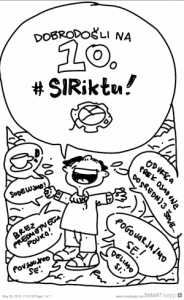Alenka Pokeržnik, Srednja ekonomska šola Maribor in Jadranka Čopi, OŠ Bratov Polančičev, Maribor
Taking responsibility for learning is one of the key competencies that we wish to teach our pupils and students at all levels of schooling. Looking back at our school days we are realizing that peer assistance was much more present, and we were able to learn more either by helping or by receiving help from others. We were eager to transfer this experience to the youth of today. Learners were taught a simple fact: If you want to help others, you have to prove that you possess sufficient knowledge on the topic you want to teach. Our idea was to pull off a cooperative project involving the students in the 1st year of secondary school (from this point referred to as students) and the 4th graders of primary school (from this point referred to as pupils). We found a suitable topic that is in the curriculum at both levels – the variety of living organism on earth. We planned a lesson on the topic of microscope. We came up with a for-step learning plan: 1. PREPARATION IN THE CLASSROM – students Students revised their knowledge of microscopy and systematics of living organisms. They recorded a scene in which they demonstrated microscopy. The movie was equipped with interactive content using applications Zaption. The movie was sent to the pupils, along with the worksheets that students prepared for the pupils. 2. PREPARATION IN THE CLASSROM – pupils After teaching the 4th graders about the diversity of living organisms I motivated them to think about an interesting fact: some of the creatures’ eyes are not visible with the naked eye, but they can be seen through a microscope. We watched a movie made by students and answered questions that we were given by them. A link to the video was placed to our virtual classroom. Pupils had to prepare themselves for working with the microscope so they brought a variety of organisms they wanted to observe through a microscope with them. 3. COOPERATIVE WORK IN THE CLASSROOM The planned duration of this stage was two lessons. After the arrival of the pupils from primary school to secondary school, pupils and students were ranked in doubles (student + pupil). The students helped pupils to use the microscope. They observed various slides – those who were brought by the pupils and those who were prepared by the students. They completed the worksheets. 4. ANALYSIS The feedback about cooperation between students and pupils has been very positive. Students were well prepared to pass on their knowledge and took their task very seriously. Pupils accepted the students as professional teachers despite their youth. Pupils remember the two lessons they have spent learning from older students with a lot of excitement.
